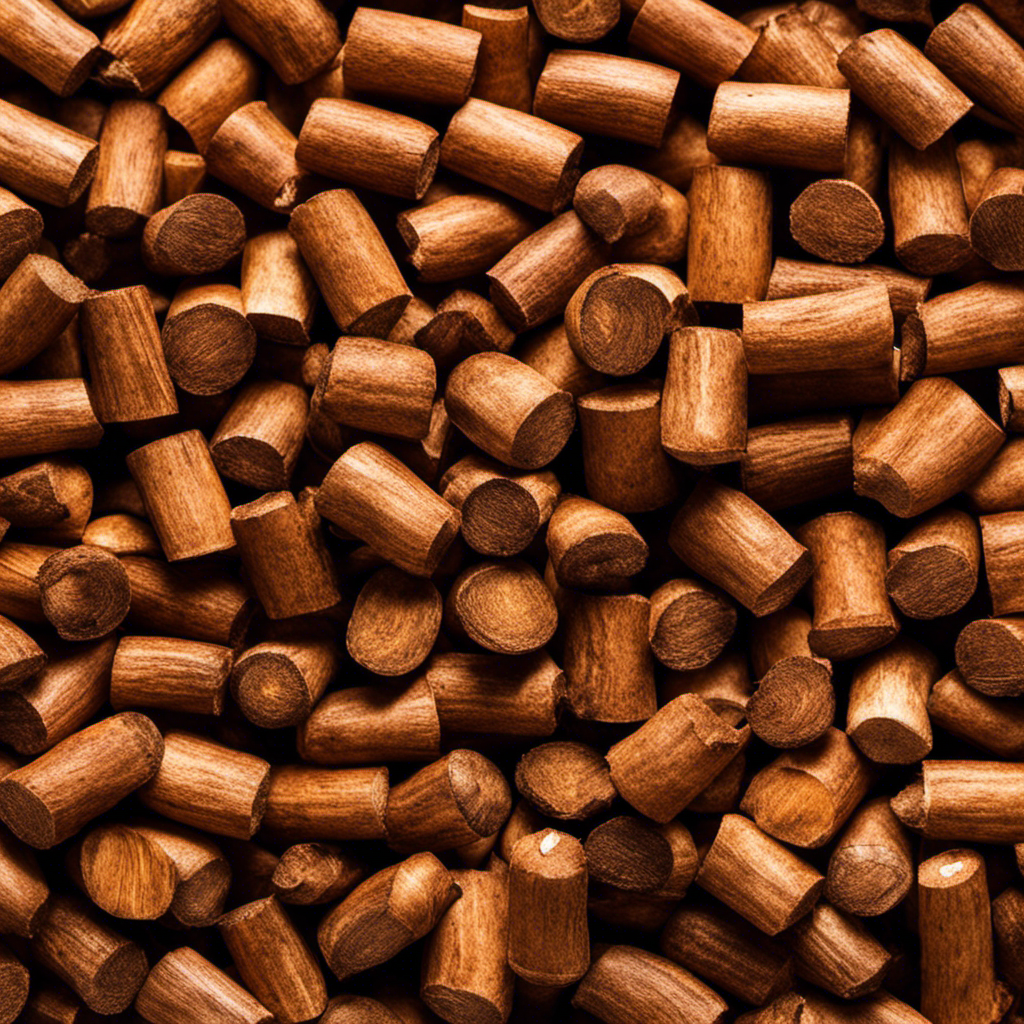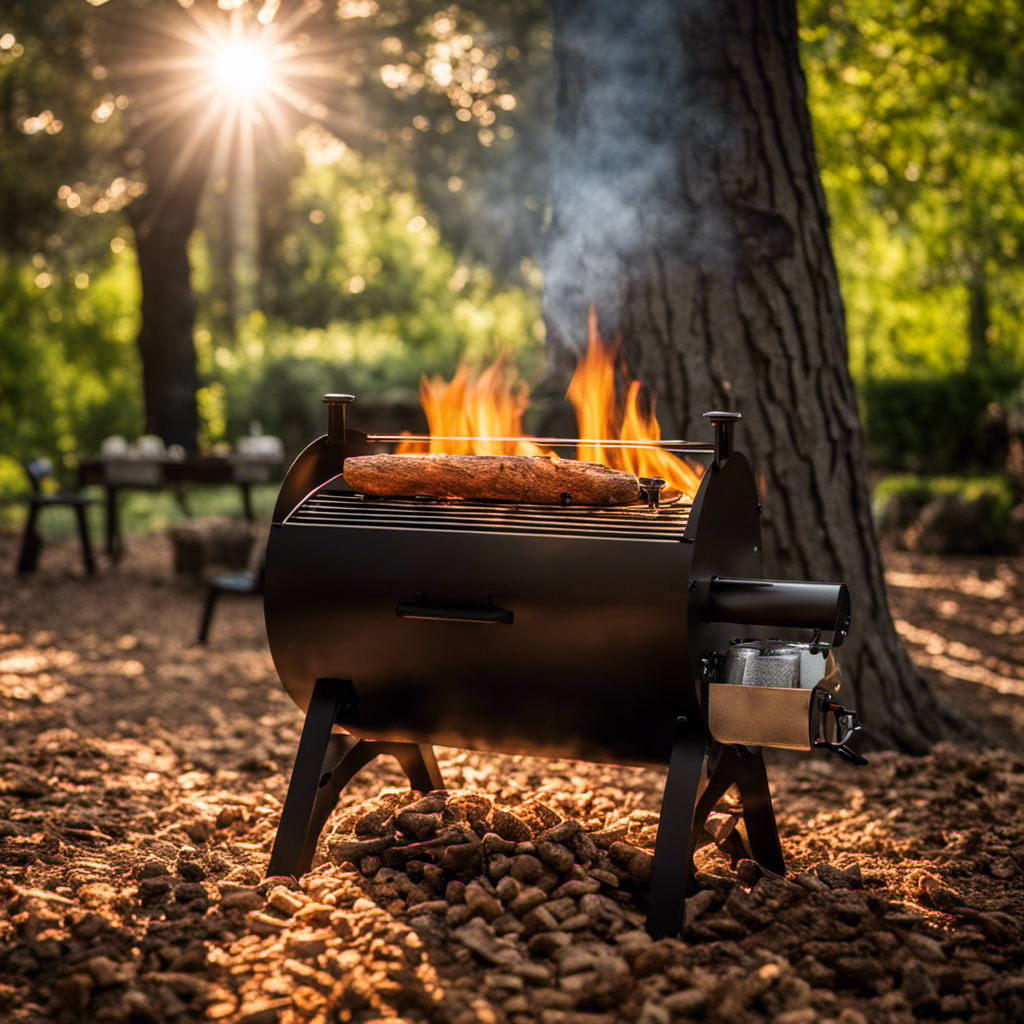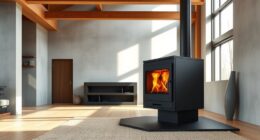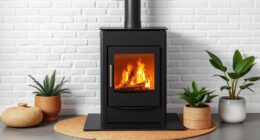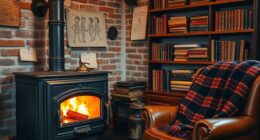As someone who appreciates wood pellet stoves, I’ve experienced the frustration of dealing with a stove covered in soot. It feels similar to having a car that continuously emits exhaust fumes into your garage.
But what causes this issue? In this article, we will explore the various factors that lead to a wood pellet stove sooting up. From improper fuel quality to inadequate air supply, we’ll delve into the technical details and provide you with the knowledge needed to keep your stove running clean and efficient.
So let’s dive in and uncover the secrets to a soot-free wood pellet stove.
Key Takeaways
- Fuel contamination, such as dirt, dust, and moisture, can lead to incomplete combustion and soot buildup.
- Insufficient air supply and ventilation can cause incomplete combustion, release of pollutants, and increased soot production.
- Regular cleaning and maintenance of the stove, chimney, air intake vents, and removing ash and debris are essential to prevent soot accumulation and maintain stove performance.
- Damaged components like igniters, augers, and exhaust fans, as well as incorrect stove settings, can contribute to inefficient combustion and increased soot generation.
Improper Fuel Quality
Improper fuel quality can cause a wood pellet stove to soot up. Fuel contamination and combustion inefficiency are the main culprits behind this issue.
When the fuel used in the stove is contaminated, it leads to incomplete combustion. Contaminants such as dirt, dust, or moisture can interfere with the combustion process, causing the stove to produce more soot.
Additionally, if the fuel is of low quality or not properly processed, it can result in inefficient combustion. In such cases, the stove may not burn the fuel completely, leading to the deposition of soot on the stove’s surfaces and chimney. This build-up of soot not only reduces the stove’s efficiency but also poses a fire hazard.
Transitioning into the subsequent section, inadequate air supply is another factor that can contribute to sooting up a wood pellet stove.
Inadequate Air Supply
You might not realize it, but if you don’t have enough air flowing into your stove, it can cause a buildup of soot. This may seem like a minor issue, but it can have significant impacts on both air pollution and your health. Here are three key points to consider:
-
Impact of air pollution: When a wood pellet stove doesn’t receive enough air, incomplete combustion occurs, leading to the release of pollutants into the air. These pollutants contribute to air pollution, which can have detrimental effects on the environment and human health.
-
Health risks associated with soot buildup: Soot contains tiny particles that can penetrate deep into the lungs when inhaled. Prolonged exposure to these particles can lead to respiratory issues, such as asthma, bronchitis, and even heart problems.
-
Increased risk of fires: Inadequate air supply can cause a buildup of soot and creosote in the stove and chimney. These highly flammable substances increase the risk of chimney fires, putting both your property and your loved ones in danger.
Insufficient cleaning and maintenance is another factor that can contribute to soot buildup and will be discussed in the next section.
Insufficient Cleaning and Maintenance
When it comes to the insufficient cleaning and maintenance of wood pellet stoves, there are several key points to consider.
Firstly, a neglected chimney can cause soot buildup, leading to reduced efficiency and potential hazards.
Secondly, clogged air intake vents can restrict the flow of air, resulting in poor combustion and increased soot production.
Lastly, the lack of regular cleaning, including removing ash and debris, can further contribute to the accumulation of soot and decrease the overall performance of the stove.
It is crucial to address these issues to ensure optimal functionality and safety.
Neglected Chimney Causes Soot
A neglected chimney can cause a wood pellet stove to soot up. Chimney cleaning is an essential part of maintaining a wood pellet stove and ensuring its efficient and safe operation. Here are three reasons why a neglected chimney can lead to soot buildup and increase the risk of carbon monoxide:
-
Reduced Airflow: A chimney clogged with debris restricts the flow of air, preventing proper combustion and causing the stove to produce more soot.
-
Incomplete Combustion: Soot is formed when there is incomplete combustion. A dirty chimney hinders the release of smoke and gases, leading to incomplete combustion and the accumulation of soot.
-
Backdrafting: A blocked chimney can cause a backdraft, where harmful gases like carbon monoxide are forced back into the living space instead of being expelled outdoors.
As we explore further, we’ll discover how clogged air intake vents can also contribute to soot buildup.
Clogged Air Intake Vents
To prevent clogging, regularly cleaning your air intake vents is crucial for maintaining the efficiency and safety of your wood pellet stove. Restricted airflow caused by dirty or blocked filters can lead to a decrease in the stove’s performance and an increase in the production of soot. Cleaning the air intake vents ensures that the stove receives an adequate supply of oxygen for combustion, allowing it to burn the wood pellets efficiently.
Here is a table to illustrate the importance of regular cleaning:
| Restricted Airflow | Dirty or Blocked Filters | Consequences |
|---|---|---|
| Decreased stove performance | Reduced oxygen supply | Inefficient combustion |
| Increased production of soot | Incomplete burning of wood pellets | Soot buildup in the stove and chimney |
| Higher risk of chimney fires | Poor air quality in the room | Health hazards and potential property damage |
Failure to regularly clean the air intake vents can result in a lack of proper combustion, leading to increased soot buildup in the stove and chimney. This can pose a fire hazard and compromise the overall performance of the wood pellet stove.
Lack of Regular Cleaning
Regularly cleaning your air intake vents is important for maintaining the efficiency and safety of your wood pellet stove. Ignoring the buildup of soot can lead to reduced heating performance, increased fuel consumption, and even the risk of a chimney fire.
Here are three reasons why regular cleaning is crucial:
-
Importance of professional maintenance: While cleaning the vents yourself is a good start, it’s also important to have your stove professionally serviced on a regular basis. A trained technician can inspect and clean the entire system, ensuring optimal performance and identifying any potential issues.
-
Dangers of ignoring soot buildup: Soot buildup not only reduces the stove’s efficiency, but it can also release harmful pollutants into your home, such as carbon monoxide. Breathing in these pollutants can have serious health consequences, so it’s crucial to keep your vents clean and clear.
-
Increased risk of chimney fire: Soot is highly flammable, and if it accumulates in the chimney, it can ignite and cause a dangerous fire. Regularly cleaning your air intake vents helps prevent soot from reaching dangerous levels and reduces the risk of a chimney fire.
Incorrect Stove Settings
Adjusting your stove settings incorrectly can cause your wood pellet stove to soot up. It is important to understand the optimal stove temperature and how it affects the combustion process.
When the stove temperature is too low, incomplete combustion occurs, leading to the production of soot. On the other hand, if the stove temperature is too high, it can result in excessive heat, which can also cause soot buildup.
To prevent this, refer to the manufacturer’s guidelines for recommended stove settings and follow them carefully. It’s also crucial to understand the different settings on your stove and how they affect the combustion process. By adjusting the settings properly, you can ensure efficient combustion and minimize the risk of soot buildup.
Now, let’s move on to the next section where we will discuss the impact of damaged or worn-out components on soot buildup.
Damaged or Worn-Out Components
In the previous section, we discussed how incorrect stove settings can lead to a wood pellet stove sooting up. Now, let’s explore another potential cause: damaged or worn-out components.
A wood pellet stove operates through a precise combustion process, and if any of its components are faulty, it can disrupt this process and cause soot buildup. Here are three common replacement parts that might contribute to the issue:
- Igniter: A faulty igniter can lead to incomplete combustion, resulting in excessive soot production.
- Auger: If the auger is damaged or worn-out, it may fail to deliver the correct amount of pellets to the combustion chamber, causing inefficient burning and increased soot generation.
- Exhaust fan: A malfunctioning exhaust fan may not properly vent the combustion gases, leading to soot accumulation.
Now that we’ve covered the impact of damaged or worn-out components, let’s move on to discussing the role of environmental factors in soot buildup.
Environmental Factors
When it comes to environmental factors, you’ll want to consider factors like humidity and temperature in order to prevent excessive soot buildup in your wood pellet stove.
Soot buildup can have a significant impact on indoor air quality, releasing harmful particles into the air that can be detrimental to your health.
High humidity levels can cause the wood pellets to produce more moisture and release more soot particles when burned. On the other hand, low humidity levels can result in incomplete combustion, leading to increased soot production.
Temperature also plays a crucial role in sooting. If the stove’s temperature is too high, it can cause rapid and incomplete combustion, resulting in more soot. Conversely, if the temperature is too low, it can lead to inefficient burning and increased soot production.
Frequently Asked Questions
Can a Wood Pellet Stove Soot up if the Fuel Quality Is Subpar but the Stove Is Properly Maintained?
If the fuel quality is subpar, it can cause a wood pellet stove to soot up, even if the stove is properly maintained. The impact of fuel quality on sooting cannot be overlooked.
What Are Some Signs That Indicate Inadequate Air Supply as the Cause of Sooting in a Wood Pellet Stove?
Inadequate air supply can cause sooting in a wood pellet stove. It’s important to ensure proper ventilation for optimal combustion. Additionally, subpar fuel quality can also contribute to sooting, leading to reduced efficiency and potential maintenance issues.
Is It Possible for a Wood Pellet Stove to Soot up Even if It Is Regularly Cleaned and Maintained?
Even with regular cleaning and maintenance, a wood pellet stove can still soot up. Factors such as poor ventilation or using low-quality pellets can contribute to increased sooting in the stove.
How Can Incorrect Stove Settings Contribute to Sooting in a Wood Pellet Stove?
Incorrect stove settings can contribute to sooting in a wood pellet stove. Factors such as the wrong air-to-fuel ratio or improper temperature settings can lead to inefficient combustion and the buildup of soot. Regular maintenance, including cleaning and ensuring fuel quality, is also crucial to prevent sooting.
Are There Any Specific Environmental Factors That Can Cause a Wood Pellet Stove to Soot Up, Besides Those Already Mentioned in the Article?
Environmental factors such as humidity and altitude can contribute to sooting in a wood pellet stove. Additionally, poor fuel quality, such as pellets with high ash content or moisture levels, can also cause increased soot buildup.
Conclusion
Well, folks, after diving into the intricate workings of wood pellet stoves, it’s clear that a sooty situation can arise from a variety of factors. From subpar fuel quality to neglecting regular cleaning, these stoves require more attention than your average household appliance.
But fear not, for knowledge is power! By understanding the potential culprits behind soot buildup, we can take the necessary precautions to keep our wood pellet stoves running smoothly.
So, let’s all raise our brushes and air supplies in a toast to a soot-free future! Cheers!
Logan’s affair with adventure began in childhood. He hailed from a small town where vast forests bordered one side and endless shores stretched on the other. His days were spent exploring uncharted woods, climbing tall trees, or listening to the tales of old sailors. This early immersion in a world brimming with stories and mysteries became the foundation of his passion for writing.


